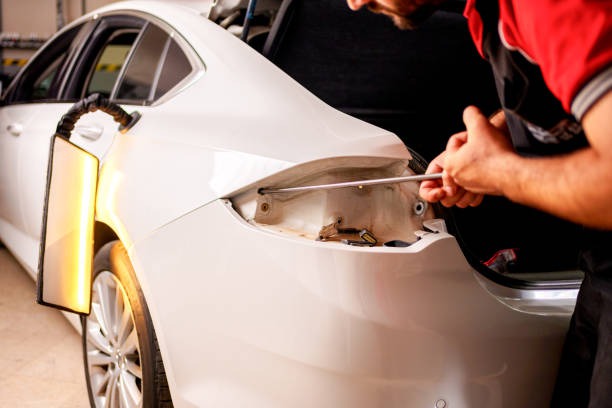
Blog
How to Choose the Right Security Camera for Your Needs
Choosing the right security camera can be a daunting task. With various features and options available, it’s hard to decide which one suits your needs. Whether it’s monitoring your home or business, finding the right camera is essential for peace of mind. Determining Your Needs Start by determining what you need the security camera for. Different scenarios require specific features. Home Security Do you need to monitor the exterior or interior of your home? Is night vision necessary for low-light conditions? Do you prefer a wired or wireless system? Business Security Are you monitoring entry points or the entire premises? How many cameras will be required for full coverage? What is your budget for installation and maintenance? Types of Security Cameras Security cameras come in various forms, each with unique advantages. Understanding these can help you make an informed choice. Dome Cameras Dome cameras are ideal for indoor use. They offer a wide view and are resistant to tampering due to their shape. These cameras are ideal for monitoring large areas within homes or businesses. Bullet Cameras Bullet cameras are recognizable by their cylindrical shape. They are typically used for outdoor surveillance. These cameras are weatherproof and can capture high-definition footage over long distances. Key Features to Consider When selecting a security camera, certain features are more critical based on your needs. Resolution Resolution determines the clarity of the camera’s footage. High-definition (HD) cameras provide clearer images, which can be crucial for identifying intruders. Field of View The field of view refers to the camera’s viewing angle. A wider field of view covers more area, reducing the number of cameras needed for complete surveillance. Night Vision Night vision capability allows the camera to record quality footage in low-light conditions. Infrared (IR) cameras are particularly useful for nighttime surveillance. Connectivity Security cameras can be wired or wireless. Wired cameras are generally more reliable but can be more challenging to install. Wireless cameras offer easier installation and more flexibility in placement. For those considering a security system Dayton, local providers can offer a balance of comprehensive features and reliable customer service. They often better understand typical security concerns in the area, ensuring your needs are met effectively. Indoor and Outdoor Cameras The placement of your security camera dictates whether you should opt for an indoor or outdoor model. Each type has its advantages and specific design features. Indoor Cameras Indoor cameras are made to blend with home interiors. They usually have fewer weather-resistant features but offer advanced functionalities like motion detection and audio recording. Outdoor Cameras Outdoor cameras are built to withstand harsh weather conditions. They are typically more robust and have features like waterproof housing and extended temperature ranges. You should look into security camera systems in Cincinnati, as many local companies offer tailored solutions that cater to the specific security needs of the region. Opting for such systems ensures you get both high-quality surveillance and support customized for your environment. Storage Options Choosing how your security footage will be stored is another key factor. Different storage options have their pros and cons. Cloud Storage Cloud storage methods offer the convenience of accessing footage from anywhere. They often come with subscription fees but provide enhanced security through remote storage. Local Storage Local storage, such as hard drives and SD cards, are physically stored on the premises. This type of storage allows for easier access but can be vulnerable if the device is damaged or stolen. Sometimes, it’s necessary to involve professionals who offer Ohio private investigation services to enhance your security. Expert investigators can employ advanced surveillance methods, ensuring your property is comprehensively monitored. Their services often include setup and ongoing management, providing an extra layer of security. Budget Considerations Ensure you have a clear budget in place when shopping for security cameras. Costs vary widely based on features and technology. Basic models: Affordable but with fewer features. Mid-range models: Offer a balance of cost and functionality. High-end models: Feature-rich but can be expensive. Installation and Maintenance The complexity of installing security cameras can vary. Decide if you’ll hire a professional or do it yourself. Maintenance also plays a role in long-term effectiveness. DIY Installation DIY installation can save costs but may require additional time and effort. Ensure you follow instructions carefully for optimal performance. Professional Installation A professional installation guarantees correct setup and may include a warranty or ongoing support. This option is often pricier but can save you future headaches. Closing Remarks Choosing the right security camera is essential for safeguarding your property. By understanding your specific needs and considering the factors outlined, you can make an informed decision. Ensure your camera system fits your requirements and provides the peace of mind you deserve.
Equine Care Essentials: When to Seek an Emergency Vet for Horses
Ensuring your horse receives adequate preventive care is crucial for their overall health and longevity. Regular maintenance and attention can often prevent severe health issues that require immediate medical intervention. This guide will provide comprehensive tips on preventive care practices for horses and outline when it is imperative to seek an equine emergency vet. Common Preventive Care Practices Preventive care encompasses a variety of routine practices aimed at maintaining your horse’s health and detecting any potential problems early on. Here are some key areas to focus on: 1. Routine Vaccinations Adhere to a vaccination schedule recommended by your veterinarian to protect against diseases such as tetanus, influenza, and West Nile Virus. Regular booster shots are essential to maintain immunity levels. Keep a record of vaccination dates and types administered. 2. Dental Check-Ups Schedule dental exams at least once a year to prevent issues like sharp enamel points, ulcers, and tooth decay. Floating (filing) of teeth may be necessary to ensure proper chewing and digestion of food. Regular dental care can prevent weight loss and behavioral issues related to mouth pain. 3. Hoof Care Trim hooves every 6-8 weeks to prevent overgrowth and associated problems like cracks and infections. Work with a skilled farrier to balance the hooves properly and maintain soundness. Ensure clean and dry bedding to minimize hoof infections like thrush. 4. Diet and Exercise Provide a balanced diet tailored to your horse’s age, breed, and activity level. Avoid sudden changes in diet to prevent digestive issues. Ensure regular exercise to maintain fitness and prevent obesity. Assess and adjust feed portions according to seasonal changes and workload. Importance of Routine Veterinary Check-Ups Regular veterinary check-ups are crucial for early detection of potential health issues and overall maintenance of your horse’s health. These exams are as detailed and essential as a comprehensive cat check up or other animal check up, for that matter, ensuring all aspects of the animal’s health are reviewed. During routine check-ups, the vet will perform a thorough physical examination, checking for signs of illness or injury. Blood tests, fecal exams, and other diagnostic tests may be conducted to detect internal problems. Early detection can save money in the long run by avoiding costly treatments for advanced diseases. Routine check-ups help maintain vaccination schedules and other preventive care measures. Signs Your Horse Needs an Emergency Vet Despite the best preventive care, emergencies can still occur. It is vital to recognize signs that warrant immediate veterinary attention to address the issue promptly: Colic: Symptoms include rolling, kicking at the abdomen, sweating, and restlessness. Lameness: Sudden or severe limping, difficulty moving, or reluctance to bear weight on a limb. Respiratory Distress: Rapid or labored breathing, nasal discharge, and coughing. Severe Injuries: Deep cuts, excessive bleeding, or visible bone fractures. Behavioral Changes: Unusually aggressive or lethargic behavior, loss of appetite, or anxiety. If you observe any of these symptoms, it is crucial to seek horses urgent vet care in San Angelo, TX, immediately. Receiving prompt attention from a specialized veterinarian can be life-saving. Preparing for Equine Emergencies Assembling an Emergency Kit Bandages and wound dressings Antiseptic solutions and ointments Thermometer and stethoscope Scissors and tweezers Vet contact information and medical records Having Contact Information Ready Keep a list of local veterinary clinics and emergency vets handy. Know the emergency contact numbers for your primary vet and a nearby equine specialist. Familiarize yourself with the location of the nearest San Angelo emergency animal hospital for quick access during a crisis. Parasite Control and Management Parasites can pose serious health risks to horses, including weight loss, colic, and anemia. Effective parasite control programs are essential to maintain your horse’s health. Regular Deworming: Follow a strategic deworming protocol as advised by your veterinarian. Rotate deworming medications to prevent resistance. Fecal Egg Counts: Perform regular fecal egg count tests to determine the parasite burden and efficacy of your deworming program. Pasture Management: Rotate pastures to prevent overgrazing and lower parasite load. Remove manure regularly to interrupt the parasite’s life cycle. Grooming and Hygiene: To minimize the risk of parasite infestation, keep your horse well-groomed and maintain clean living conditions. Benefits of Preventive Care Investing time and resources in preventive care has numerous benefits, both for the horse and the owner: Regular check-ups can detect and treat minor issues before they escalate into severe problems. Effective preventive measures reduce the frequency and severity of emergency vet visits, saving money and reducing stress. Consistent care improves the horse’s overall health, lifespan, and quality of life. Maintaining health records and a preventive care schedule also ensures compliance with equine health regulations. Final Thoughts Preventive care for horses is an essential aspect of responsible ownership. Regular veterinary check-ups, vaccinations, dental care, hoof maintenance, and proper diet and exercise routines all contribute to a healthier, happier horse. By diligently following preventive care practices, you can minimize the need for emergency interventions and ensure the well-being of your equine companion. Schedule routine exams and always be prepared for emergencies by knowing the nearest vet and keeping an emergency kit ready.
What Causes Bad Breath and How Do I Prevent It?
Struggling with bad breath can be an embarrassing hurdle in social situations. Whether it’s during an important meeting or a date, bad breath has the uncanny ability to appear at the most inconvenient times. Understanding the root causes and prevention strategies can help you tackle this common problem effectively. Common Causes of Bad Breath Bad breath, medically known as halitosis, isn’t always indicative of poor hygiene. Here are some common culprits: Bacteria: Your mouth is home to hundreds of bacteria types, which thrive on food particles left in your mouth, producing foul-smelling waste. Poor Oral Hygiene: Not brushing or flossing regularly allows food particles to linger, causing bad breath. Gum Disease: Persistent bad breath can be an early sign of gum disease, which is caused by plaque buildup. Dry Mouth: Saliva helps cleanse your mouth. Without it, bad breath can occur due to a condition called xerostomia. Food and Drink: Items like garlic, onions, and alcohol can lead to transient bad breath. Tobacco Products: In addition to posing serious health risks, smoking or chewing tobacco can give you bad breath. While these are some of the common causes, there are also medical conditions like certain cancers and certain metabolic disorders that can contribute to bad breath. Dental issues, such as missing or decaying teeth, can also lead to bad breath. In such cases, treating the underlying condition is crucial. Opting for solutions like teeth implants in Palm Coast can help improve oral health and reduce bad breath. Maintaining Fresh Breath Keeping your breath fresh throughout the day is an important aspect of personal hygiene. Fortunately, there are several effective steps you can take to ensure that you feel confident about your breath at all times. Regular Oral Hygiene One of the most significant factors in maintaining fresh breath is practicing regular oral hygiene. Brush at least twice a day with fluoride toothpaste to help remove food particles and plaque buildup. Floss daily to clean between your teeth, eliminating debris that a toothbrush may miss. This prevents bacteria from thriving and producing unpleasant odors. By prioritizing oral hygiene, you can dramatically reduce bad breath and promote a healthier mouth overall. Stay Hydrated Another vital step in ensuring fresh breath is staying hydrated. Drinking plenty of water throughout the day helps rinse out your mouth and prevents dry mouth. Avoid excessive consumption of alcohol and caffeine, as these can contribute to dehydration and exacerbate bad breath. Proper hydration can also encourage saliva production, which is essential for neutralizing acids and cleaning the mouth. Watch Your Diet Your diet can also have a significant impact on your breath. Avoid foods that are known to sour your breath, such as garlic and onions, especially before social occasions. In addition, eating a balanced diet rich in fruits, vegetables, and whole grains improves your overall health, which in turn benefits your oral health and can help reduce bad breath. Making mindful dietary choices can contribute to freshness and promote good health. Creating a Fresh Breath Routine In summary, maintaining fresh breath is achievable by following these simple steps: Commit to regular oral hygiene by brushing and flossing daily. Stay hydrated to support saliva production and rinse away bacteria. Be mindful of your diet to avoid foods that can leave lingering odors. By consistently applying these practices, you can enjoy fresh breath and increased confidence throughout your day. Remember that a little effort in maintaining oral hygiene can lead to better overall health and well-being. Professional Oral Health Practices Alongside home care, professional dental treatments play a vital role in maintaining oral hygiene and, by extension, combating bad breath. Regular Dental Checkups Visiting your dentist regularly for cleanings and checkups ensures that any plaque buildup is removed and potential issues are identified before they escalate into serious problems. Advanced Dental Techniques If underlying oral health issues are causing bad breath, your dentist may recommend more advanced treatments. For instance, procedures like dental ridge augmentation techniques can restore the contour of the gums and jawbone, which is not only beneficial for dental health but can also aid in alleviating bad breath caused by periodontal problems. Tackling Bad Breath at Home Beyond professional care, there are daily habits you can adopt to minimize bad breath: Use an antibacterial mouthwash to fight off oral bacteria. Chew sugar-free gum to stimulate saliva production and dislodge food particles. Quit smoking or using tobacco products for your overall health and breath. Remember, remedies like mouthwash and gum should complement, not replace, basic oral hygiene practices. When to See a Doctor or Dentist You should seek professional advice if your bad breath persists despite good home care, particularly if you experience other symptoms such as toothaches, bleeding gums, or pain while chewing, as it may indicate a more serious condition. Specialized Periodontal Procedures For cases where bad breath is associated with sinus issues, professionals might suggest specialty procedures such as sinus grafting at Bergens Periodontics & Implant Dentistry, which not only helps in dental implant placements but also in ensuring the overall health of the oral cavity. Closing Remarks In summary, bad breath can be caused by a variety of factors ranging from dietary habits to complex health conditions. Regular oral hygiene, proper hydration, a balanced diet, and routine dental visits are all solid defenses against halitosis. For more stubborn cases, advanced dental treatments can be invaluable. By implementing these strategies, you can say goodbye to bad breath and feel more confident in your interactions.
What Is the Role of Diet in Maintaining Healthy Teeth?
Everyone desires a bright, healthy smile, and while brushing, flossing, and regular dental checkups are essential, what one eats plays a significant role in oral health. A balanced diet can bolster tooth strength, curb bacteria, and prevent numerous dental issues. Nutrients That Promote Oral Health A range of nutrients is vital to maintaining healthy teeth. Calcium: Essential for strong teeth and bones, calcium can be found in dairy products, leafy greens, and fortified foods. Phosphorus: Often found in proteins such as meat, eggs, and nuts, this mineral works in tandem with calcium to fortify teeth. Vitamin D: It helps absorb calcium and can be obtained from sunlight, fatty fish, and fortified foods. A diet rich in these nutrients supports dental health by reinforcing tooth enamel and reducing the risk of tooth decay and gum disease. Foods to Embrace for Oral Health Some foods are particularly beneficial for teeth: Cheese and yogurt are excellent for their high calcium content and ability to balance the mouth’s pH level. Fiber-rich foods like fruits and vegetables increase saliva flow, which is crucial in warding off cavities and gum disease. Green and black teas contain polyphenols that help manage bacteria, reducing the risk of cavities and gum inflammation. Choosing these foods can contribute to healthier teeth and gums, and when included in a balanced diet, they help maintain overall health too. Foods and Habits to Avoid Conversely, certain foods and habits can negatively impact oral health. Sugary snacks and drinks should be limited as sugar feeds bacteria that produce harmful acids attacking tooth enamel. Sticky or chewy candies and dried fruits can cling to teeth, which may lead to decay. Hard foods like ice can damage tooth surfaces or cause fractures. Avoiding or limiting these can protect your teeth from unnecessary damage and dental issues. Acidic Impact on Teeth A diet high in acidic foods and beverages can erode tooth enamel over time, leading to sensitivity and cavities. It’s not just what you eat but how often you consume acidic items. Frequent snacking without proper dental hygiene can increase the risk of acid erosion. Therefore, moderating the intake of acidic food and drink, while ensuring a diligent oral care routine, is key. Oral Health and Overall Wellness Oral health is deeply connected to overall wellness, with diet being a common link. Gum disease, for instance, has been associated with broader health issues such as diabetes and heart disease. Prioritizing a diet beneficial for oral health can contribute to a healthier body overall. Maintaining a Balance Balancing one’s diet is vital to oral health. It’s about enjoying a variety of foods while being mindful of those that can harm oral health. Consistency in eating patterns allows for better planning and reduces the temptation of impulsive snacking on harmful foods. Regularly incorporating foods that strengthen teeth, alongside proper dental hygiene, can form a strong defense against many oral health problems. Minimally Invasive Dental Care In line with a healthy diet, advancements in dental care, such as minimally invasive laser gum treatment, offer innovative ways to manage dental health with precision and reduced discomfort. Such advanced treatments not only preserve healthy tissue but also speed up recovery times and are a testament to the evolving nature of oral healthcare. Regular Dental Checkups and Personal Habits Even with a diligent diet, regular dental visits are essential. Professionals can detect early signs of problems that might not be immediately apparent. They can also offer additional guidance on personal habits, such as brushing techniques and the right oral care products, that complement a tooth-friendly diet. Incorporating habits like drinking plenty of water and avoiding tobacco products also makes a significant difference in maintaining a healthy mouth and supporting the benefits of a mindful diet. Seeking Professional Advice For those seeking quality dental care in Tracy, CA, consulting with dental professionals allows one to receive personalized dietary recommendations that align with their oral health goals. Experts can help navigate nutritional choices to enhance dental health while addressing any existing dental conditions with a comprehensive approach tailored to individual needs. Diet and Oral Health for Children For children, establishing a healthy diet early on is critical to developing strong teeth. Limiting sugary drinks, including juices, and instilling good eating habits set the foundation for long-term oral health. Additionally, creating a positive environment around dental care helps children see it as just another important part of their routine. Parents and caregivers play a crucial role in educating and monitoring children’s dietary choices and ensuring they stay on the path to good oral health. Exploring Orthodontic Options When considering orthodontic treatment, understanding the difference between invisalign and traditional braces is crucial as it can impact dietary choices during treatment. With aligners, there are fewer dietary restrictions compared to braces, which may require avoiding certain crunchy or sticky foods. Closing Remarks To sum it up, diet plays a pivotal role in maintaining healthy teeth. Consuming foods rich in essential nutrients and being cautious of damaging substances like sugar and acid are key lifestyle choices for preserving oral health. Coupled with current dental treatments and professional guidance, securing a beautiful smile is an attainable goal. Remember, oral health is a reflection of one’s overall health, so take care of your teeth by minding what you eat!
Financial Planning for Real Estate: How to Budget for Property Investments
Thinking about diving into real estate investments? Whether you buy your first rental property or expand your portfolio, financial planning is crucial. Budgeting appropriately can help you make informed decisions and avoid common pitfalls. In simple, conversational English, let’s explain how to create a solid financial plan for your property investments. How to Budget for Property Investments Regarding property investments, budgeting is all about understanding your finances and planning for various costs. Here’s a straightforward guide to help you get started. Assess Your Financial Situation The first step is to assess your financial health. You need to have a clear picture of your current financial situation. Here’s how to go about it: Check your savings: Determine how much money you’ve saved for investment purposes. Review your credit score: A good credit score can help you get better loan terms. Analyze your income and expenses: Understand your regular income and outgoing expenses to see what you can afford to invest. Set Clear Investment Goals It’s essential to set clear goals for your property investment. Are you looking for long-term rental income, or do you want to flip properties for a quick profit? Rental income: This approach focuses on buying properties to rent out and earn monthly income. Property flipping: This involves buying properties at a lower price, renovating them, and selling them at a higher price. Determine How Much You Can Afford Knowing how much you can afford to spend on a property is vital. Consider factors like down payment, mortgage, maintenance, and unexpected expenses. Down Payment: Typically, you’ll need 20% of the property’s purchase price. Mortgage: Evaluate different mortgage options and find out what your monthly payments will be. Maintenance and Repairs: Allocate funds for regular upkeep and potential repairs. Unexpected Costs: Set aside extra money for unforeseen expenses. Research the Market Understanding the real estate market can help you make smarter investment choices. Here’s what to do: Analyze trends: Look at current market trends in the area you’re interested in. Study property values: Understand how property values have changed over time. Check rental rates: If you plan to rent, research current rental rates in the area. For example, working with an Oakland real estate agency can provide you with valuable insights into the local market trends, property values, and rental rates in Oakland. Secure Financing Once you know how much you can afford, the next step is to secure financing. Here are your options: Traditional Mortgages: Available through banks and credit unions. Private Lenders: These are individuals or companies willing to lend money. Hard Money Loans: These are short-term loans typically used for flipping properties. Companies like California Pacific Realty can assist and guide in securing the right financing for your property investment needs. Factor in Ongoing Costs Remember, owning an investment property comes with ongoing costs. Here’s what to keep in mind: Property management fees: If you plan to hire a property management company, factor in these costs. Taxes: Property taxes can vary greatly depending on the location. Insurance: Protect your investment with the right insurance coverage. Using property management services in Oakland can be beneficial if you’re investing, as they can help you manage the property efficiently and handle ongoing costs. Create an Emergency Fund Setting up an emergency fund specifically for your investment properties is wise. This can help cover unexpected expenses or vacancies, ensuring financial stability even in tough times. Monitor Your Investment Once you’ve purchased a property, keep an eye on your investment. Regularly review its performance and make adjustments as needed. This can involve: Tracking rental income Monitoring property values Updating maintenance schedules Speak with Experts Finally, speaking with real estate experts can provide additional insights and help you make informed decisions. Real estate agents, property managers, and financial advisors can be invaluable resources. Final Thoughts Budgeting for property investments doesn’t have to be daunting. You can make informed decisions and build a profitable real estate portfolio by assessing your financial situation, setting clear goals, understanding ongoing costs, and seeking expert advice. Always remember that informed and strategic planning is critical to successful real estate investments.
Pet Wellness Programs: An Overview of Preventative Care Packages
Hey there, pet parents. If you’re anything like us, your pet is a cherished member of your family. Keeping our furry friends healthy and happy isn’t just a priority—it’s a passion. That’s why understanding pet wellness programs and preventative care packages is so important. In this article, we’ll break down what these packages are, why they’re beneficial, and how they can possibly save you big bucks (and stress) in the long run. What are Pet Wellness Programs? Pet wellness programs are structured plans designed to keep your pet in peak health through preventative care. These programs usually include a range of services such as regular check-ups, vaccinations, diagnostic tests, dental care, and even nutritional counseling. The goal? To catch potential health issues early before they become major problems. Why Preventative Care Matters Preventative care is all about proactively managing your pet’s health. Think of it like this: wouldn’t you rather catch a small issue during a routine check-up than face a full-blown emergency later on? Regular veterinary visits, vaccinations, and other preventative measures play a crucial role in maintaining your pet’s well-being. They help to detect and treat conditions early, extending the quality and length of your pet’s life. What’s Included in Wellness Programs While specific packages may vary, most pet wellness programs include: Annual or bi-annual veterinary exams Core vaccinations (rabies, distemper, etc.) Diagnostic tests (blood work, fecal exams) Dental cleaning and care Parasite prevention (flea, tick, heartworm treatments) Nutritional and weight management counseling These services collectively aim to prevent health issues and ensure your pet remains in optimal shape. What’s more, many veterinary clinics offer customized packages tailored to different age groups, such as puppies, adult pets, and senior pets. Benefits of Enrolling in a Pet Wellness Program So, why should you consider enrolling your pet in a wellness program? Let’s get into the specifics: Early Detection of Health Issues One of the standout benefits of these programs is the early detection of health problems. Routine diagnostic tests and veterinary exams can reveal underlying issues that you might not notice at home. For example, a routine blood test might catch early signs of kidney disease or diabetes, allowing for timely intervention. Cost Savings While it might seem counterintuitive, investing in a wellness program can save you money in the long run. By spreading out the costs of routine care into affordable monthly payments, you avoid the financial burden of sudden, unexpected medical bills. Additionally, many wellness packages include discounts on additional services and products. Peace of Mind Knowing that your pet is regularly monitored and cared for brings peace of mind. You’ll feel more secure knowing that you’re doing everything possible to keep your pet healthy and happy. A dedicated wellness program keeps you on track with necessary health check-ups and treatments. Customized Care Wellness programs often offer customized care tailored to your pet’s specific needs. Whether you have a puppy, an adult dog, or a senior cat, there’s likely a program designed to address their unique health requirements. Personalized care plans ensure that your pet is getting exactly what they need at each life stage. Additionally, if your pet requires specialized care, such as services from an internal medicine veterinarian, a wellness program can help coordinate and streamline those services. How to Choose the Right Wellness Program With so many options available, picking the right wellness program for your pet can be a bit overwhelming. Here are some factors to consider: Evaluate Your Pet’s Needs First and foremost, consider your pet’s specific needs. A senior pet might need more frequent exams and diagnostic tests, while a young, healthy pet might need more basic preventative care like vaccinations and parasite control. Your veterinarian can help guide you on what’s best for your pet. Check What’s Included Review what’s included in each package. Does it cover all the essential services your pet needs? Are there any additional benefits like discounts on other services? Ensure that the package aligns with your pet’s health requirements and your budget. Consider the Costs Compare the costs of different wellness programs. While cheaper packages might be tempting, they may not offer the comprehensive care that a slightly pricier package does. Remember, the goal is to provide thorough preventative care that will save you money in the long run. Did you know that some clinics, like the ones offering veterinary laboratory services, include lab tests in their wellness packages? This can be an added benefit, providing you with a more comprehensive look into your pet’s health. Making the Most of Your Wellness Program Once you’ve chosen a wellness program, it’s important to make the most out of it. Here’s how: Stay on Schedule Keep up with all scheduled exams, vaccinations, and treatments. The effectiveness of a wellness program hinges on consistency. Missing appointments can mean missing early signs of potential issues. Communicate with Your Vet Maintain open communication with your vet. If you notice any changes in your pet’s behavior, eating habits, or physical condition, report them immediately. Early intervention can make all the difference. Use the Included Services Many wellness programs offer additional perks like grooming, teeth cleaning, or nutritional counseling. Take advantage of these services to maximize the value of your program. For example, if you’re dealing with a pet that’s a bit overweight, nutritional counseling included in the package can be super helpful. Also, be aware of specialized care options. If your pet requires surgical care, knowing that your clinic provides veterinary surgery services in Nashua can bring added convenience and peace of mind. Common Misconceptions About Wellness Programs Some pet owners might have reservations about wellness programs due to common misconceptions. Let’s debunk a few of these: They’re Too Expensive While the upfront cost may seem high, wellness programs often save you money over time. By covering routine care and offering discounts on additional services, these programs can be more cost-effective than paying for each service individually. My Pet is Healthy and Doesn’t Need It Even healthy pets benefit from regular check-ups and preventative care. Health issues often develop gradually and can go unnoticed until they become serious. Regular wellness exams catch these problems early, ensuring your pet stays healthy. I Can Do it All Myself While you provide essential daily care, veterinary professionals bring expertise that you may not have. Regular veterinary check-ups and diagnostic tests cover areas you might not be equipped to handle at home. Wellness programs offer professional oversight that complements your home care efforts. Wrapping Up Pet wellness programs offer a structured and cost-effective way to ensure your furry friend stays healthy year-round. They provide a comprehensive range of services that cover all the bases of preventative care, from vaccinations and dental care to nutritional counseling. By enrolling in a wellness program, you’re investing in your pet’s long-term health and well-being. Remember to consult with your veterinarian to choose the program that best suits your pet’s needs. After all, keeping our pets healthy is a top priority.
What Home Remodeling Projects Deliver the Best ROI for Homeowners?
Thinking about renovating your home for a fresh look and higher value? Not all improvements offer the same financial return. Focus on upgrades that enhance aesthetics and boost your home’s market value. We’ll cover the renovations that deliver the best return on investment (ROI) for homeowners. No extra fluff—just straightforward advice to make your home look great while ensuring smart financial gains. The Home Improvement Projects That Shine in ROI 1. Kitchen Overhaul It’s been said that kitchens sell homes, and it’s true. An outdated kitchen can be a deal-breaker, but a modern, functional one can seal the deal. Here’s the kicker: you don’t need to go for a full-blown kitchen remodel to see a decent ROI. Sometimes, minor updates like refreshing the cabinets with a new coat of paint, upgrading appliances, or swapping out old countertops for sleek, new surfaces can bring significant returns. Seeking professional Chicago remodeling services can make the transformation even smoother and more impactful. And let’s be honest, everyone loves a pretty kitchen. 2. Bathroom Bonus Next to the kitchen, there are bathrooms, where you can see a solid ROI. Again, it doesn’t take a sledgehammer to make a difference. Simple fixes like re-tiling, updating fixtures, or even adding a new vanity can elevate the look and the value. If you have a bit more to invest, consider creating a modern master suite – that’s a hot-ticket item for many homebuyers. 3. Curb Appeal Champions Curb appeal: it’s the attractiveness of a property and its surroundings when viewed from the street. Improving your home’s exterior, including landscaping, new siding, or even just a fresh coat of paint, can make a world of difference. Don’t forget the front door. It’s like the smile of your home, and a vibrant, welcoming entrance can make a stellar first impression. 4. Enhancing Efficiency Who doesn’t love a lesser utility bill? Upgrading to energy-efficient windows, insulation, and HVAC systems isn’t exactly the sexiest of home improvements, but it sure pleases the wallet. Both in the monthly savings and potentially in the resale value. Buyers are increasingly looking for homes that will be cost-effective to maintain. 5. Adding More Space Size matters, at least when it comes to home value. Adding square footage – or even the illusion of it – pays off. Whether it’s a deck, an attic bedroom, or an extra bathroom, extra space is equivalent to extra value. And let’s talk about home additions at Augustyn Builders; they have a knack for seamlessly blending the new with the old, ensuring your add-on looks like it has always been a part of your home. 6. The Basement Beneath If you have an unfinished basement, you’re sitting on a gold mine. Finishing this space can yield a return based on the extra livable square feet it provides. From a simple entertainment area to a rentable apartment, the possibilities – and the potential ROI – are pretty extensive. Now that we’re up to speed on what projects may bring in the cash at closing let’s answer a common question. How do you find the right team for the job? searching for directions to top builders in Chicago could lead you to a crew that turns your investment into a goldmine. 7. The Value of Curb Appeal First impressions are everything, and your home’s exterior is no exception. A dilapidated facade or overgrown garden can quickly turn off potential buyers, while a pleasant exterior with tidy landscaping and a welcoming entrance can attract positive attention. So, peel out those old shrubs, slap on some paint, and maybe even redesign your front porch. Sprucing up curb appeal often requires less cash outlay than interior renovations and can provide an impressive return on a modest investment. 8. Painting A Picture of Profit Never underestimate the power of a fresh coat of paint. It’s one of the most cost-effective ways to update your space and provides a substantial return for a relatively low expense. Opt for neutral colors for broad appeal. Remember, some folks might not share your love for fuchsia or lime green. Building Upon What’s There ROI isn’t just about adding new features; it’s also about enhancing what you already have. Refinishing hardwood floors, for instance, can be a game-changer. Have a fireplace? Make it a focal point. Small tweaks can add significant value. you might want to consider a fresh approach to your renovation projects. That could mean anything from knocking down an unnecessary wall to creating an open floor plan to installing smart tech to bring your home into the 21st century. Final Thoughts Home remodeling can be profitable if you choose the right projects. Focus on updates that modernize, add functional living space, improve energy efficiency, or enhance curb appeal. Planning well and teaming up with experienced professionals can ensure wise investments. Balance your taste with market appeal, and you might achieve a great return on investment. The key is selecting renovations that not only enhance your daily living but also appeal to future buyers, making your project a worthwhile investment.
Low-Level Laser Therapy Explained: A Comprehensive Guide for Pet Owners
Low-level laser therapy (LLLT) is an innovative approach to enhancing pet health through noninvasive means. This therapy has gained considerable interest among pet owners seeking advanced treatments to alleviate their pets’ discomfort and improve their quality of life. In this guide, we will explore the basics of LLLT, how it works, its benefits, safety measures, and what to expect during a session. What is Low-Level Laser Therapy? Low-level laser therapy, also known as cold laser therapy, involves the use of low-intensity lasers to stimulate cellular function, promoting healing and pain relief. Unlike high-intensity laser treatments used in surgeries, LLLT is noninvasive and painless, making it suitable for both cats and dogs. How Does It Work? LLLT uses specific wavelengths of light to penetrate tissue and stimulate cellular activity. Here’s how it works: The laser emits photons, which are absorbed by the cells in the targeted tissue. This absorption stimulates the mitochondria, the cell’s powerhouse, leading to increased production of ATP (adenosine triphosphate). Increased ATP production enhances cellular function, speeding up the healing process. The therapy also helps reduce inflammation, increase blood circulation, and accelerate tissue repair. Benefits for Cats and Dogs Pets can gain numerous advantages from LLLT. For instance, cold laser treatment for dogs and cats has shown remarkable effectiveness in managing chronic pain and arthritis, enabling pets to regain mobility and enjoy a higher quality of life. Other conditions where LLLT can be beneficial include: Reducing inflammation caused by injuries or infections. Accelerating the healing of skin wounds and post-surgical incisions. Alleviating pain associated with degenerative joint diseases. Improving recovery times for sprains and strains. Is It Safe? Safety is a critical concern for pet owners, and LLLT is designed to be a highly safe procedure. The risk of side effects is minimal, and the therapy is noninvasive, avoiding the complications associated with surgeries and medications. When administered by trained professionals, LLLT is safe and effective. Common concerns and their mitigations include: There is minimal risk of burns or tissue damage due to low-intensity lasers. It is non-toxic and does not require pet sedation. Usually, there is no discomfort or pain during the sessions, keeping pets calm and stress-free. What to Expect During a Session Understanding what happens during an LLLT session can ease any apprehension pet owners might have. Here’s a step-by-step walkthrough of a typical session: Initial Consultation: A thorough assessment of your pet’s condition by the veterinarian. Preparation: Pets should be groomed to allow easy light penetration. No specific fasting or medication adjustments are usually required. Therapy Session: The pet is comfortably positioned. The laser device is applied to the targeted area, often for several minutes. Owners can often stay with their pets to keep them relaxed. Post-Therapy Care: No special aftercare is necessary, but veterinarians may provide advice on activities and monitoring. Who Can Administer It? It’s crucial to seek LLLT from trained professionals to ensure its efficacy and safety. Typically, certified veterinarians and technicians administer the therapy. Before starting any advanced treatments like LLLT, ensuring pets are up-to-date with their vaccinations is paramount. Clinics that offer comprehensive dog vaccination services are generally well-equipped to provide holistic care, combining preventive and therapeutic approaches for optimal pet health. Frequently Asked Questions 1. What kind of conditions can LLLT treat? LLLT can treat a variety of conditions, including chronic pain, arthritis, inflammations, skin wounds, and post-surgical recovery. It’s particularly effective in managing conditions like hip dysplasia and tendonitis. 2. How long are the therapy sessions? Therapy sessions typically last between 5 to 20 minutes, depending on the size of the area being treated and the severity of the condition. Frequency and duration are tailored to the pet’s specific needs. 3. Does pet insurance cover it? Coverage for LLLT varies by insurance provider. It’s advisable to check with your pet’s insurance company to understand the specifics of your policy and whether it includes coverage for advanced treatments like LLLT. How to Find the Right Veterinary Clinic Choosing the right veterinary clinic is essential for ensuring your pet receives high-quality care. Here are some tips for selecting a reputable clinic: Look for clinics with certified and experienced staff who specialize in advanced treatments. Consulting an experienced animal surgeon in Ruckersville is advisable, especially for specialized treatments like LLLT. Check online reviews and ask for recommendations from other pet owners. Consider the range of services offered. A clinic providing comprehensive care, from diagnostics to treatment and aftercare, ensures all aspects of your pet’s health are addressed. Evaluate the clinic’s facilities and equipment. Modern, well-maintained equipment is crucial for effective treatment. Final Thoughts Low-level laser therapy represents a safe and effective way to enhance your pet’s well-being. By understanding how the therapy works and its benefits and ensuring qualified professionals administer it, pet owners can make informed decisions about incorporating LLLT into their pet’s healthcare routine. Consult your veterinarian to explore whether LLLT is a suitable option for your pet and take proactive steps towards ensuring a happier, healthier life for your furry friend.
How to Ensure Consistent Product Quality When Buying Wholesale Flooring
Ensure consistent product quality when buying wholesale flooring. Whether you’re sourcing for a residential renovation or a commercial project, flooring quality can make or break the entire outcome. But as anyone who has shopped in bulk knows, maintaining high quality across large orders can be tricky. It’s essential to take the proper steps to ensure the flooring you purchase meets your standards without unpleasant surprises down the line. This article will discuss the best practices for consistently getting top-quality flooring when buying wholesale for your home or business. Strategies for Assuring Quality in Wholesale Flooring Transactions 1. Work with Reputable Suppliers Working with a reputable wholesaler is the first and most crucial step to ensuring consistent product quality. Not all suppliers are created equal, and choosing a company with a solid reputation can save you a lot of headaches. Look for wholesalers who have been in business for a long time and have good customer reviews. This way, you’ll know they have a track record of delivering quality products. Also, ensure the supplier has specific experience in your purchasing flooring. For instance, if you’re looking for vinyl or hardwood, a supplier specializing in those materials will be better equipped to ensure quality. If you’re searching for a flooring wholesaler in Arizona, find one with a strong reputation in that region, as local expertise can also play a role in product reliability. 2. Request Product Samples One of the most effective ways to gauge the quality of the flooring is to request product samples before making a large purchase. Wholesale orders can be substantial, so seeing and feeling the product firsthand can help you make a more informed decision. Ask for various samples, particularly if you order flooring in various finishes, styles, or colors. This can give you a good sense of the variety and ensure consistency across different batches. You should test for texture, durability, and color consistency in each sample. 3. Understand Manufacturer Specifications Another essential aspect to consider is the manufacturer’s specifications. Ensure you’re familiar with the flooring’s technical details, such as thickness, wear layer, and material composition. Knowing these specs can help you identify any discrepancies between the product you expect and what you receive. Also, pay attention to warranty details. A reputable supplier typically offers a decent warranty period, giving you peace of mind when purchasing in bulk. Always clarify the warranty terms and what is covered in case, there are any issues with the quality down the road. 4. Order in Batches Rather than placing a large order, it might be wise to order in batches, especially if this is your first time working with a new wholesaler. Ordering smaller quantities at first allows you to inspect the quality of the initial batch before committing to a more significant purchase. This approach minimizes the risk of receiving a significant amount of flooring that doesn’t meet your expectations. Once you’re confident in the quality of the first batch, you can place larger orders, knowing you’re more likely to receive consistent product quality. 5. Inspect Orders Upon Delivery Once your flooring arrives, it’s critical to inspect the order immediately. Even if you’ve worked with a reliable supplier and received quality samples, issues can sometimes arise during shipping or packaging. Inspect the flooring for any visible defects, such as warping, scratches, or color inconsistencies. If you spot any problems, contact the supplier immediately to resolve the issue. Most reputable wholesalers will offer a replacement or refund, mainly if the damage occurred during shipping. 6. Communicate Your Needs Clearly Effective communication with your supplier can significantly improve the quality of the product you receive. Be as specific as possible about your requirements, whether the flooring type, finish, color, or any other detail. Let your supplier know what you expect so they can match your needs accordingly. Clear communication also extends to discussing timelines. Ensure you and the supplier are on the same page about delivery dates, especially if you’re working on a time-sensitive project. Delivery delays can cause problems for the rest of your project, so it’s essential to confirm shipping timelines early in the process. 7. Confirm Certifications and Standards Another critical step is to confirm that the flooring products meet specific industry standards and certifications. This is particularly important when dealing with environmental standards or health and safety concerns. Look for certifications such as FloorScore for air quality or FSC for sustainably sourced wood products. These certifications provide an extra assurance that the flooring you’re buying is high-quality and adheres to important safety or environmental guidelines. 8. Build a Relationship with Your Wholesaler Building a long-term relationship with your wholesaler can pay off in the long run. Once you find a supplier who consistently delivers high-quality flooring, staying loyal can help ensure you continue receiving good products. Wholesalers are often more inclined to offer better pricing or priority service to long-term customers, which can be beneficial, especially for large projects or future orders. If you’re reading the detailed guidelines on this page, you’ll see how important it is to consider these factors to ensure you get the best flooring for your money. Additional Tips for Maintaining Quality Ensuring consistent product quality involves more than just choosing the right supplier. Here are a few more tips to consider: Research the flooring material: Different types of flooring come with unique qualities. For example, vinyl is highly durable and water-resistant, while hardwood offers a classic look. Understanding these differences can help you choose the right product. Ask about the return policy: A good return policy ensures you can return or exchange the flooring if there are quality issues. Always ask about the return and replacement policies before making a purchase. Monitor pricing fluctuations: Wholesale prices can vary depending on market conditions. If you notice a significant price drop, it might be worth checking if the product quality has been compromised. Consistency When Ordering Wholesale Vinyl Flooring For those ordering wholesale vinyl flooring in Sedona, maintaining consistency in your product quality requires the same attention to detail outlined above. Whether it’s the thickness, color, or durability, vinyl flooring can vary from one batch to another, so working with a reliable supplier, inspecting your order, and requesting samples can make all the difference. Wrapping Up Ensuring consistent product quality when buying wholesale flooring is all about making informed decisions, from choosing the right supplier to inspecting your orders. Following these tips, you can confidently buy in bulk and get high-quality flooring every time. Investing some time upfront will save you from costly mistakes and keep your projects on track.
Who Can Benefit Most from Professional Fall Cleanup Services?
As the leaves start to turn their beautiful autumn colors and gradually fall to the ground, you know it’s that time of year again – for fall cleanup. While many people might grab a rake and start tackling the task themselves, there’s a whole host of people who stand to gain considerably more from enlisting professional fall cleanup services. These services not only save time and energy but also ensure that your property is in tip-top shape for the coming seasons. Identifying Who Needs Professional Fall Cleanup Services the Most So, who would find professional fall cleanup services a blessing? Let’s get straight to the point and talk about these beneficiaries. 1. Busy Professionals and Families Time is a precious commodity for individuals with packed schedules and family responsibilities. Busy professionals who juggle work commitments with personal life, as well as families, often find it challenging to dedicate a weekend to yard work. For them, hiring professional help means they can enjoy their precious downtime rather than spending it on labor-intensive tasks like raking leaves and cleaning gutters. 2. Elderly Homeowners and Those with Physical Limitations For the elderly or individuals coping with physical limitations, engaging in the physicality of fall cleanup poses not just a challenge but also a safety risk. Thankfully, professional services can accommodate their needs, allowing them to enjoy a well-kept outdoor space without putting their health on the line. 3. Home Sellers and Real Estate Agents A pristine exterior profoundly influences first impressions. Home sellers and real estate agents stand to benefit substantially from professional cleanup services, which can help stage a property to its most appealing potential, potentially leading to quicker sales and better offers. 4. Commercial Property and Business Owners First impressions matter in business—a lot. Commercial property owners and managers understand the value of maintaining an attractive, hazard-free outdoor space. When it comes to attracting customers and creating a responsible brand image, professional cleanup services, such as Manchester landscape maintenance, ensure that the business’s façade looks inviting and well cared for all year round. This kind of dedicated service can truly enhance the overall aesthetic and safety of any commercial property. 5. Landlords and Property Managers Property maintenance is crucial for landlords and property managers who need to keep real estate in top condition for current and prospective tenants. By utilizing professional services, these owners can ensure their properties remain appealing and safe, ultimately supporting their business’s reputation and value. 6. Garden Enthusiasts Seeking a Strong Start for Spring Fall cleanup is more than mere aesthetics; it’s about setting the stage for a healthy garden in the spring. Garden enthusiasts understand the importance of removing dead leaves and debris to prevent diseases and pests in the planting beds. Accessing professional services can serve as an investment into their garden’s bountiful future. What Do Professional Fall Cleanup Services Include? Now that we’ve identified those who stand to benefit most, it’s essential to understand what these services typically entail: Raking and removal of leaves Gutter cleaning Garden bed care and mulching Pruning and trimming of trees and shrubs Lawn aeration, fertilization, and overseeding Debris and branch cleanup Having a clear understanding of these services helps in making informed decisions when it comes to property maintenance. Why Choose Professional Services Over DIY? We’re in the age of doing it ourselves, but let’s be honest, some tasks are better left to the pros. Here are a few reasons why going with a professional service might be the better option: Efficiency and Time-Saving: These experts have the tools and techniques to get the job done quickly and effectively. Safety: Equipment like tall ladders can pose risks. Professionals are trained to handle such tools with care. Expertise: Pros have a keen eye for details most of us might overlook, such as pest infestations or diseased foliage. Convenience: By hiring professionals, you’re free to spend your time on what matters most to you. Plus, the specialized services these professionals offer, such as aeration and overseeding, can be crucial to long-term landscaping health and aesthetics but might require expertise or equipment that the average homeowner doesn’t have. Selecting the Right Fall Cleanup Services Once you have decided that professional help is needed, the last piece of the puzzle is choosing the right Manchester fall cleanup services. Here are quick tips on what to consider: Look for providers with solid reputations and positive reviews. Ensure they are insured and bonded for safety and liability reasons. Ask about their experience with properties similar to yours. Understand what’s included in their packages so there are no surprises. Get an estimate to ensure their services align with your budget expectations. Environmental Considerations Apart from the convenience and aesthetic appeal, professional fall cleanup services often take environmentally friendly approaches. They might offer sustainable disposal of yard waste or use eco-conscious products and methods that minimize any negative environmental impacts, which can be a significant draw for those who are eco-friendly-minded. Moreover, landscape services in Manchester, NH, often incorporate these same green practices for those residing in the area. This way, residents can enjoy a beautifully maintained yard while also contributing to a healthier environment. Final Thoughts Fall signifies transition, preparation, and beautification. Professional fall cleanup services support overworked professionals, those with physical challenges, property sellers, business leaders, and gardening enthusiasts. These services offer numerous benefits, ensuring homes and businesses look attractive and promoting a healthy outdoor environment. If dealing with fallen leaves and debris seems daunting, professional care can simplify your autumn tasks and enhance the beauty of your property.





















